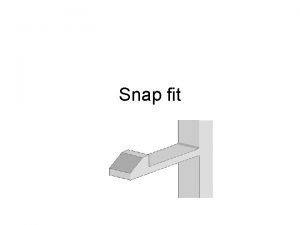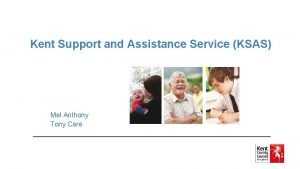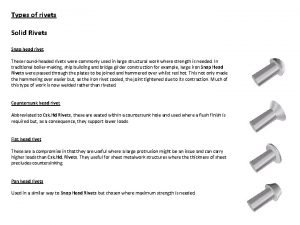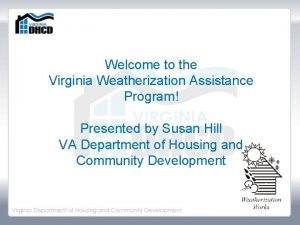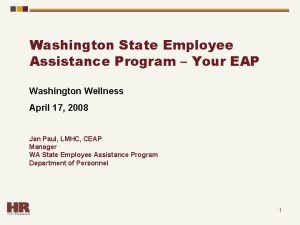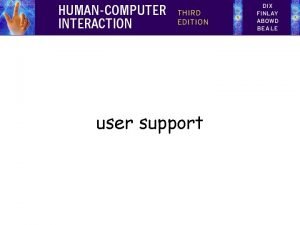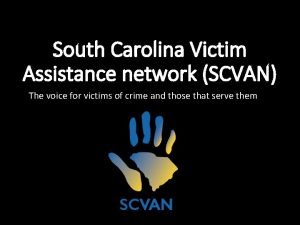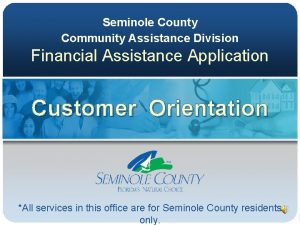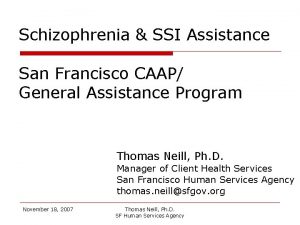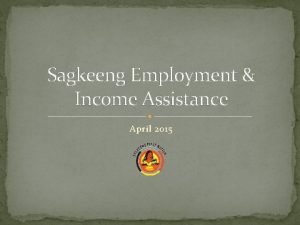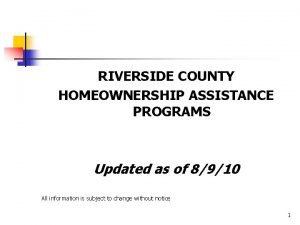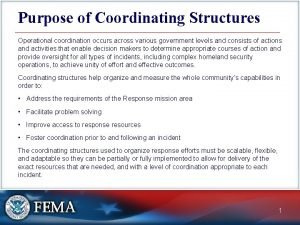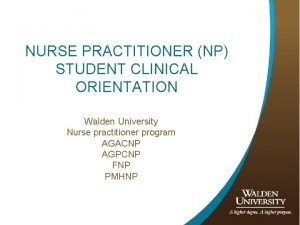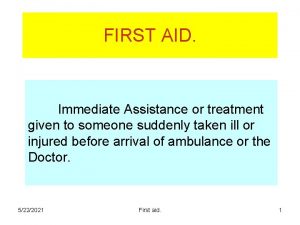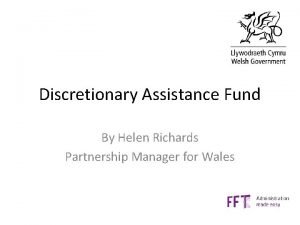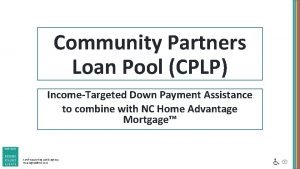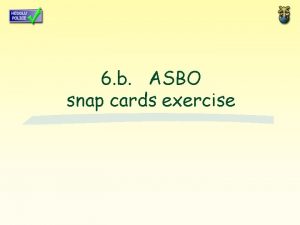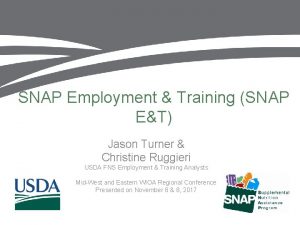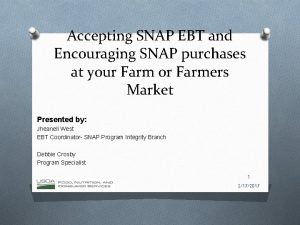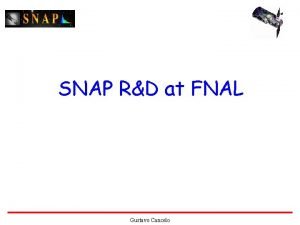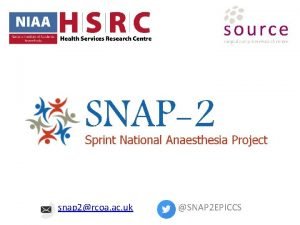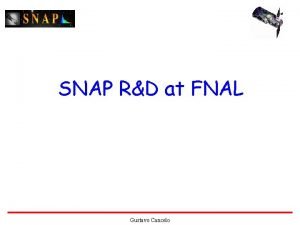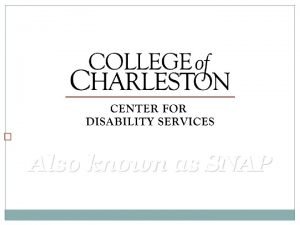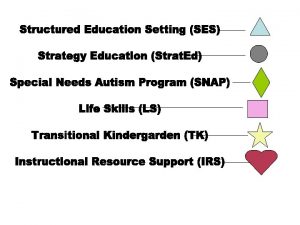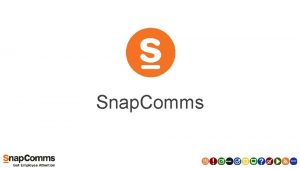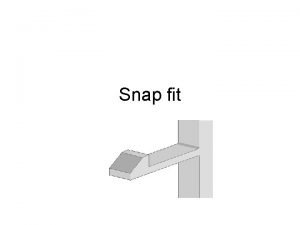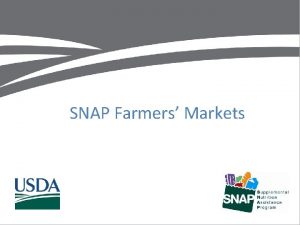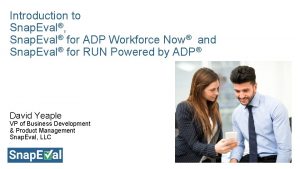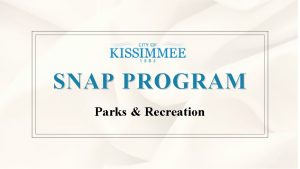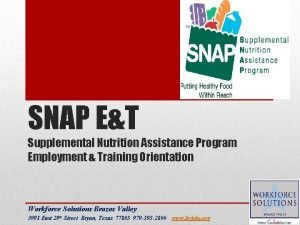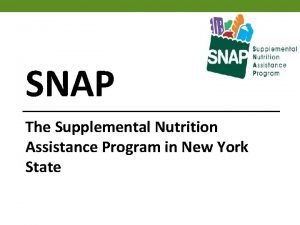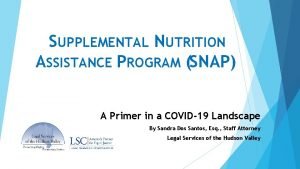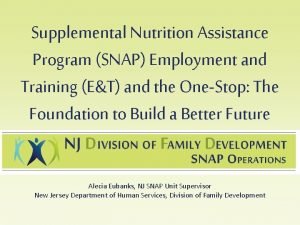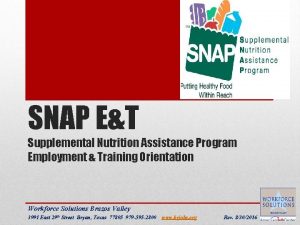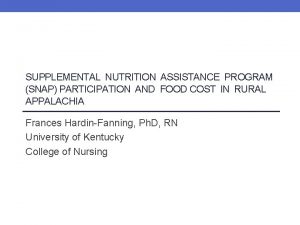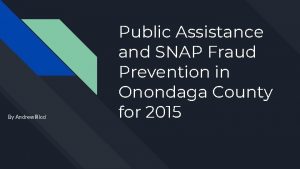SNAP APPLICATION ASSISTANCE 1 AGENDA GOALS Understand SNAP


























- Slides: 26

SNAP APPLICATION ASSISTANCE 1

AGENDA & GOALS Understand SNAP basics Basics of SNAP outreach SNAP college student eligibility Become familiar with online application Review paper application Tips on offering follow-up assistance 2

WHAT IS SNAP? “First line of defense” against hunger Formerly known as “Food Stamps” Provides food assistance to households with low incomes 3

OUTREACH MESSAGING TO STUDENTS: § What, Who, & How § What is SNAP? § Who may qualify? § How do you apply? § Addressing Misconceptions 4

SNAP APPLICATION ASSISTANCE & OUTREACH While providing application assistance on campus is an important way to connect more eligible students to SNAP, getting the word out about SNAP is also very crucial. SNAP outreach can be as simple as doing class raps about SNAP, tabling at events on campus and having posters hanging in your office or classroom. Let faculty, staff and students across campus know about SNAP, where they can go to find out more and where they can find help with filling out the application. 5

SNAP AND COLLEGE STUDENT ELIGIBILITY 6

THE BASICS OF STUDENT ELIGIBILITY Are you a student of higher education? Is your income at or below a specified threshold? Do you meet the additional criteria? 7

WHO IS A STUDENT OF HIGHER EDUCATION? 18 years of age or older but under age 50 Attending an institution of higher education (beyond high school) This includes: Vocational, technical, business, and trade schools that normally require a high school diploma or GED for enrollment. Enrolled at least half-time (as defined by the institution) Note: If a student does not meet ALL three of these criteria, they do not need to meet the additional student criteria when applying for SNAP. 8

THE BASICS OF STUDENT ELIGIBILITY 9

WHAT COUNTS AS INCOME? Earned income: such as, gross earned income from employment. Unearned income: such as, income from cash assistance programs (like TANF), Social Security, unemployment insurance, disability, child support, some financial aid (if it used for personal expenses outside of paying for tuition, school materials, or school fees, etc. ), scholarships through the Veteran Administration and other private scholarships. 10

MAINTAINING YOUR STUDENT ELIGIBILITY Student breaks: Student’s enrollment status continues through school vacations and summer breaks if the student intends to return to school for the next term. (There is no reporting required if you are a student on break). 11

NEW STUDENT CRITERIA Students will be asked to explain their employment/job goals and how their educational plan helps them achieve these goals to the DHS worker during their interview. DHS wants to understand the link between the student’s education and a job. It’s okay for the job they think they’ll be doing to change in the future, but the student needs to share how their college education is helping them get employment/a job. The education program a student is pursing must be intended to be completed in 4 -years or less. No work requirements 12

ADDITIONAL STUDENT CRITERIA If you do not meet the new criteria, there are still other ways to qualify: Be awarded work study - you do not need to have a position secured when you apply, but you need to intend to find a position in the coming school term. Working 20 hours a week Unable to work due to physical or physiological difficulties. May need to provide a note from a counselor, advisor, student support services, or medical professional. Participating in a WIOA approved program. Find programs on the Eligible Training Provider List (ETPL), see oregonhunger. org/snap-for -students for the list. Caring for a child under the age 6 or a single parent with a child under 13 the age of 12.

OTHER FACTORS AFFECTING STUDENT ELIGIBILITY Meal plans If a student’s meal plan pays for less than half of their meals per week and they qualify for SNAP in other ways, then meal plans won’t affect their eligibility. Immigration status Use table from Frequently Asked Questions about SNAP from Students as a resource 14

APPLYING FOR SNAP: DHS PROCESS Application filled out and submitted. 30 days from application submission to complete the application process. Call from DHS to schedule an interview. Interview with DHS Benefit and Eligibility worker. Paperwork may be requested as proof of income, etc. Eligibility determined. If Eligible: EBT/Oregon Trail card picked up or mailed. Pin number set by recipient Benefits disbursed monthly EBT card used just like a debit card. 15

COORDINATING APPLICATION ASSISTANCE 16 SETTING UP A CAMPUS-WIDE REFERRAL PROCESS

APPLICATIO N ASSISTANCE 17

APPLICATION ASSISTANCE PROCESS STEPS 1. Review: Income guidelines Are you a student of higher education? Student eligibility 2. Help student complete & submit application 3. Offer follow-up assistance 4. Share “How to apply for SNAP” handout 5. Let student know they can advocate their case. 18

APPLYING FOR SNAP 19 OREGON ONLINE SNAP APPLICATION

PAPER SNAP APPLICATION : HIGHLIGHTS AND TIPS Available in multiple languages Application form is for SNAP, TANF, EDRC & Medical Assistance SNAP only applicants fill-out pages 1 -7, read 13 -15 & sign page 15 Paper applications can be mailed or dropped off in person. 20

FOLLOW-UP ASSISTANCE After a student completes and submits their SNAP application we recommend offering follow-up assistance. Providing follow-up assistance is a critical step in the application assistance process. The purpose is to ensure that applicants are contacted in a timely manner by DHS, are treated fairly, and are properly connect to benefits according to their eligibility. If the student requests follow-up support, you can collect their contact information and get in touch with them after a week and make sure everything is going okay with the application process. 21

22

23

24

PROVIDING SNAP APPLICATION ASSISTANCE You provide an access point to help connect students to SNAP resources You can provide information to empower students to make informed decisions You can help navigate a sometimes complicated application process You are NOT a DHS eligibility worker You can’t determine eligibility 25

QUESTIONS ? 26
 Strategic goals tactical goals operational goals
Strategic goals tactical goals operational goals Strategic goals tactical goals operational goals
Strategic goals tactical goals operational goals To understand recursion you must understand recursion
To understand recursion you must understand recursion Filing snap fit snap maylundentechcrunch
Filing snap fit snap maylundentechcrunch Ksas apply online
Ksas apply online Agenda sistemica y agenda institucional
Agenda sistemica y agenda institucional Snap head rivet vs pop rivet
Snap head rivet vs pop rivet General goals and specific goals
General goals and specific goals Examples of generic goals and product-specific goals
Examples of generic goals and product-specific goals Virginia weatherization assistance program
Virginia weatherization assistance program Employee assistance program washington
Employee assistance program washington What are the 4 main types of assistance that users require?
What are the 4 main types of assistance that users require? Writ of assistance
Writ of assistance North carolina victim assistance network
North carolina victim assistance network Social assistance definition
Social assistance definition Seminole county community assistance
Seminole county community assistance General assistance in san francisco
General assistance in san francisco Sagkeeng social assistance
Sagkeeng social assistance Riverside county home buyers
Riverside county home buyers How do coordination structures help organize
How do coordination structures help organize Nehemiah down payment assistance
Nehemiah down payment assistance Walden student assistance program
Walden student assistance program Chancery hisd
Chancery hisd Rice first aid
Rice first aid Social assistance definition
Social assistance definition Discretionary assistance fund forum
Discretionary assistance fund forum Cplp down payment assistance
Cplp down payment assistance



